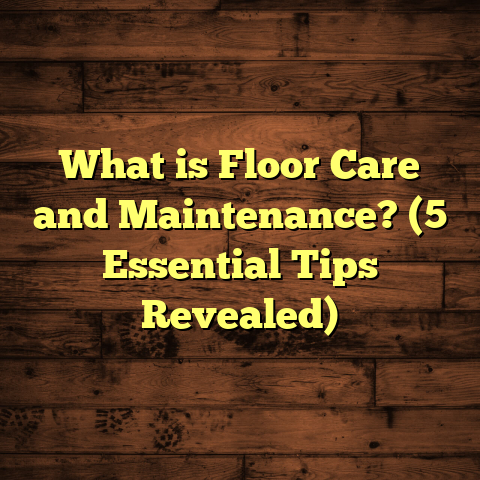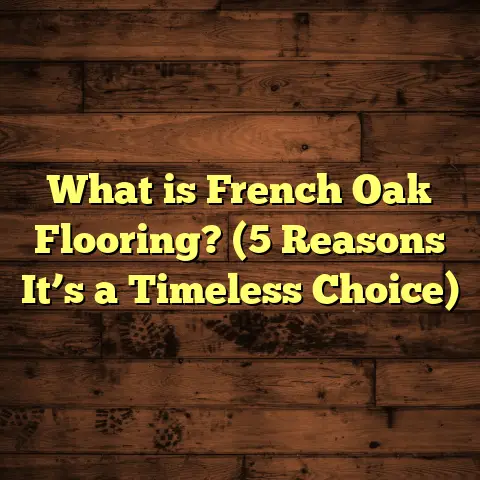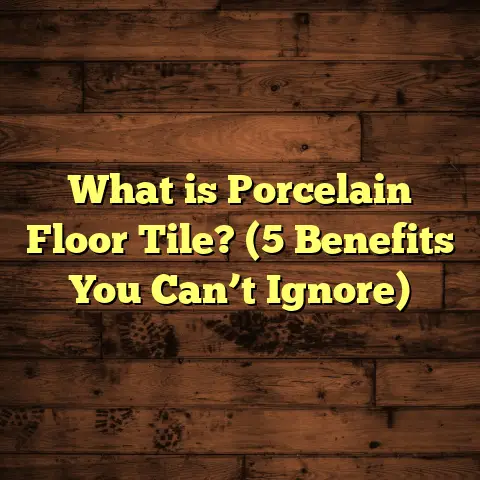What is a Metallic Floor? (5 Benefits for Modern Spaces)
Spring always makes me want to refresh my living space. The way sunlight streams through windows and bounces off surfaces inspires me to think about how floors can completely alter a room’s atmosphere. It was last spring when I took on a project that introduced me to metallic flooring in a whole new way. A client wanted something different—something that would catch the light and make their living room pop without feeling cold or industrial. After installing a metallic epoxy floor with swirling patterns of bronze and silver, the transformation was stunning. The floor became a conversation piece, with guests constantly asking about it.
That experience made me realize how metallic floors are becoming a popular choice for modern spaces—and for good reasons. So, let’s talk about what metallic floors really are and why they’re such a game changer.
What is a Metallic Floor?
You might ask, what exactly is a metallic floor? At its core, metallic flooring refers to floors finished with materials that create a highly reflective, glossy surface infused with metallic pigments. Typically, the base is an epoxy resin—a tough synthetic material known for durability. Into this resin, metallic powders like aluminum, bronze, or even copper are mixed to produce a shimmering effect.
The magic happens when these metallic pigments are suspended in clear layers of resin. Light interacts with the metal particles at different depths, creating a depth and 3D effect that shifts as you move around the room. It’s almost as if the floor is alive with subtle movement.
I first encountered this style on a commercial job where the client wanted something ultra-modern but also durable enough for heavy foot traffic. The floor was an epoxy base mixed with fine silver powder and tinted resin that gave it a smoky marble look. It wasn’t just pretty—it was also super practical.
How Are Metallic Floors Made?
The process starts with preparing the subfloor to be perfectly smooth and clean. Any imperfections would show through the clear epoxy layers. Then the epoxy resin mixed with metallic pigments is poured and spread evenly.
Multiple layers are applied to build up depth. Each layer needs time to cure before adding the next. Once the final coat is down and dry, a clear topcoat is often applied to protect the surface from scratches and wear.
Because every batch of metallic powder mixes differently, each floor ends up unique—think of it like painting with liquid metal.
Types of Metallic Floors
There are various styles depending on the metal used and design intention:
- Epoxy Metallic Coatings: Most common for residential and commercial applications.
- Metallic Tiles: Less common but available; metal tiles embedded in resin or combined with other materials.
- Metal Sheet Floors: Pure metal sheets like stainless steel or aluminum installed as flooring—typically in industrial or high-tech spaces.
Epoxy metallic floors dominate because they offer a seamless look and endless design possibilities.
Why Choose Metallic Floors? 5 Benefits You’ll Love
1. A Visual Experience That Keeps Changing
One thing I love about metallic floors is how they interact with light. The reflective pigments catch sunlight or artificial lighting to create different moods throughout the day.
I remember visiting a client’s showroom where they’d installed metallic floors in their main area. Morning light made the floor sparkle subtly like crushed diamonds. By afternoon, under warmer lights, the same surface glowed softly, emphasizing swirling patterns that looked almost organic.
If you want your floor to be more than just something underfoot—something dynamic and artistic—metallic floors deliver that experience beautifully.
2. Rock-Solid Durability That Lasts
People often ask if these floors can handle daily wear and tear. From my projects, I can confidently say yes. Because epoxy resin forms a hard plastic-like coating, it resists scratches, impacts, stains, and moisture better than hardwood or laminate.
For example, I installed metallic epoxy flooring in a busy clinic’s reception area. This space sees constant foot traffic and occasional spills of cleaning fluids. After two years, the floors still look brand new with zero cracking or dulling.
Epoxy’s resistance to chemicals also makes it ideal for commercial kitchens or laboratories where spills happen frequently.
3. Super Simple Maintenance
If you’re anything like me, low-maintenance flooring is a huge plus. Metallic floors don’t need polishing or refinishing like hardwood does. Since they’re seamless and non-porous, dirt doesn’t get trapped in cracks or grout lines.
All it takes is regular sweeping and mopping with mild soap solution to keep them looking sharp. Spills wipe up instantly without staining.
I advised one family with young kids and pets to go with metallic epoxy for this exact reason. Their busy lifestyle meant floors needed to be both tough and easy to clean—and these floors checked both boxes perfectly.
4. Endless Design Possibilities
Want your floors to match your personality? Metallic epoxy flooring can be customized endlessly. You can choose from a spectrum of colors—from soft pastels to bold jewel tones—and mix different metal powders for unique effects like gold flecks or copper veins.
The patterns can range from smooth gradients resembling marble to abstract swirls or even geometric shapes created by masking techniques during application.
A boutique restaurant I worked with chose a copper-and-bronze blend with wave patterns reflecting their coastal theme. The result was elegant without being flashy—exactly what they wanted.
5. Healthier Indoor Environment
Dust and allergens are a real concern for many homeowners. Unlike carpet or wood that can trap dust mites and pet dander, metallic epoxy floors are hypoallergenic due to their smooth surface.
Many modern epoxy formulations are also low in volatile organic compounds (VOCs), which means better indoor air quality compared to older coatings or finishes.
I installed these floors in a daycare center where health regulations were strict. Staff appreciated how easy it was to clean without harsh chemicals, making the environment safer for kids.
Diving Into the Details: Technical Insights and Data
Let me share some numbers from my experience backed by industry data:
- Durability: Epoxy-based metallic floors typically have hardness ratings between 70-90 Shore D (a measure of surface hardness), meaning they resist dents better than hardwood (about 40 Shore D).
- Lifespan: On average, well-installed epoxy floors last over 10 years without needing replacement.
- Maintenance Costs: Compared to hardwood requiring refinishing every 3-5 years at $2-$5 per square foot, metallic floors generally only need cleaning costing less than $0.50 per square foot annually.
- Slip Resistance: With additives, these floors can achieve slip resistance ratings suitable for commercial spaces (ASTM D2047 benchmark).
The combination of longevity and low upkeep often makes metallic flooring more cost-effective over time despite higher upfront installation costs.
My Personal Experiences With Installation Challenges
Not everything about metallic floors is smooth sailing—pun intended! One tricky part I’ve faced is ensuring perfect subfloor preparation. Metallic epoxy reveals every bump or crack beneath because it’s so glossy and transparent.
On one project in an older building, we had to spend extra time grinding down concrete unevenness before pouring resin layers. Skipping this step would have ruined the aesthetic and caused premature wear spots.
Also, timing between coats matters a lot. If you rush curing times or apply too thick layers at once, bubbles form or layers fail to bond properly. Patience during installation pays off big time.
Cost Breakdown: What Should You Expect?
Here’s an overview based on my recent projects:
| Item | Approximate Cost (per sq ft) |
|---|---|
| Epoxy Resin & Metallic Pigments | $8 – $15 |
| Surface Preparation | $2 – $5 |
| Labor (Application & Finishing) | $5 – $10 |
| Protective Topcoat | $1 – $3 |
| Total | $16 – $33 |
Prices vary depending on region and design complexity. Using tools like FloorTally helps me get precise estimates quickly by inputting local labor rates and material prices. It also accounts for waste factors so I order just the right amount of materials.
FloorTally saves me from juggling multiple quotes manually—it streamlines budgeting so I can focus on design and quality control instead of chasing numbers all day.
Case Study: Metallic Floors in Residential vs Commercial Spaces
Residential Example
A couple renovating their loft asked me for something modern yet warm enough for family life. We went with amber-toned metallic flooring with subtle copper swirls in their open-plan kitchen-living space.
Feedback after six months? They loved how easy cleanup was after spills and how sunlight made the floor glow warmly during evenings. Their friends were fascinated by how “liquid metal” looked underfoot while still feeling cozy.
Commercial Example
A car showroom needed floors that would impress clients while handling heavy vehicle weight and daily foot traffic. Metallic epoxy floors with silver-gray pigments were installed across 2,000 square feet.
The floor’s durability exceeded expectations; even after several months of tire marks and oil drips, it looked pristine following routine cleaning. Customers commented on how polished and futuristic the showroom felt, boosting brand perception significantly.
Comparing Metallic Floors to Other Popular Flooring Options
Let me break down how metallic floors stack up against some common alternatives:
Hardwood Flooring
- Look: Warm and natural vs cool and high-gloss.
- Durability: Hardwood scratches easily; metallic epoxy resists wear better.
- Maintenance: Hardwood needs refinishing; metallic requires simple cleaning.
- Cost: Hardwood installation varies ($8-$15/sq ft); comparable to mid-range metallic flooring.
- Environment: Hardwood can off-gas VOCs; newer epoxy options are low-VOC but synthetic.
Tile Flooring
- Look: Variety of textures but grout lines break continuity.
- Durability: Tile is hard but grout stains; metallic floors are seamless.
- Maintenance: Tile needs grout cleaning; metallic just mopped.
- Comfort: Tiles can feel cold; epoxy floors have some warmth underfoot.
- Installation: Tile requires more labor-intensive setting; epoxy pours faster over large areas.
Laminate Flooring
- Look: Mimics wood or stone but lacks depth.
- Durability: Laminate scratches easily; metallic is tougher.
- Water Resistance: Laminate swells with moisture; epoxy fully waterproof.
- Maintenance: Laminate requires gentle cleaners; epoxy handles harsher conditions well.
- Cost: Laminate cheaper upfront but less durable long-term compared to metallic floors.
Design Ideas With Metallic Floors
If you want your floor to be the centerpiece rather than just background, here are some creative directions:
- Marbled Metal: Blend colors like silver, gray, white for marble mimicry.
- Geometric Patterns: Use taping techniques between layers for sharp angles or stripes.
- Metallic Flecks: Add gold or copper flakes scattered throughout clear resin for sparkle.
- Gradient Effects: Fade colors gradually across rooms for visual flow.
- Custom Logos or Art: Embed brand logos or abstract art directly into resin layers for uniqueness.
I love brainstorming designs with clients because every project ends up one-of-a-kind.
Installation Tips From My Toolbox
Here are some pointers I always remind myself (and clients):
- Prepare your subfloor meticulously—imperfections show instantly.
- Work in temperature-controlled environments; humidity affects curing.
- Use professional-grade respirators because fumes can be strong during application.
- Don’t skimp on topcoat—it protects the color and durability.
- Plan furniture placement carefully during curing periods (usually 24–72 hours).
If you’re DIY-inclined but nervous about application details, consult professionals at least for initial steps—they can help avoid costly mistakes.
Maintaining Your Metallic Floor Over Time
Keeping these floors beautiful is pretty straightforward:
- Sweep daily or as needed to remove grit that could scratch surface.
- Mop weekly with pH-neutral cleaner; avoid acidic products.
- Use felt pads on furniture legs to prevent gouges.
- Reapply topcoat every few years depending on wear patterns.
- Address spills quickly—though most liquids won’t stain if cleaned promptly.
One client called me after five years worried about dull spots near entryways—we scheduled a quick topcoat refresh that restored shine perfectly without full replacement costs.
Final Thoughts: Are Metallic Floors Right For You?
From my experience installing dozens of projects ranging from art galleries to family homes, metallic flooring offers an exciting blend of style and function rarely matched by other options.
They’re not just for industrial lofts or high-tech offices anymore—they’re becoming accessible choices for anyone who wants their floor to reflect personality while standing up to everyday life challenges.
If you’re considering upgrading your floor this season like I did last spring, think about how much you value:
- Visual impact that adapts throughout the day
- Durability that reduces long-term costs
- Easy cleaning routines
- Design freedom
- Healthier indoor air quality
Metallic floors check all those boxes for me—and maybe they will for you too.
Have questions about whether this style fits your space? Curious about budgeting or installation? Just reach out—I’m happy to share what I’ve learned on the job!





